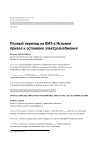Proportionality of the development of mining and processing industries in the regions of the Arctic zone of the Russian Federation
DOI: 10.33917/mic-5.124.2025.41-53
The article presents the calculated shares of the key economic activity indicators for the territories–mineral extraction and the volumes of mineral processing industries combined–and the individual enterprises’ share of extraction and processing volumes in the regions, in macroregions (federal districts), and in the Russian Federation as a whole. The authors also determined the shares of each of these economic activities in the gross regional product of individual constituent entities of the Russian Federation, macroregions, and the Russian Federation as a whole. These calculations allowed for a comparative analysis of the dynamics of these shares since 2010, determining the current proportions of these indicators, and identifying the degree of proportionality between the development of mineral extraction volumes and the volumes of mineral processing industries in the study territories.
References:
1. On approval of the strategy for the development of the mineral resource base of the Russian Federation until 2050: Decree of the Government of the Russian Federation dated July 11, 2024 No. 1838-r/ Regulatory portal «Garant». URL: https://base.garant.ru/409441699/
2. Khakulov V.A., Khakulov V.V. Excavators of robotic open-pit developments of the future. Mining. 2016;3(9):35-42.
3. Methodology for controlling the parameters of a mining system in the dynamics of mining operations to ensure the sustainable functioning of a mining enterprise in changing market conditions / Gavrishev S.E., Zalyadnov V.Yu., Kurochkin A.I., Melnik V.V., Pytalev I.A. Bulletin of Magnitogorsk State Technical University named after G.I. Nosov. 2024;22(4):5-14.
4. Pashkevich N.V., Iseeva L.I., Fedchenko A.A. Russia on the world markets reserves, production, export. Notes of the Mining Institute. 2014;208:60-64.
5. Daukaev A.A., Gatsaeva L.S., Gagaeva Z.Sh., Sobisevich A.V. Mining and geoecological problems of the 20th century. Modern problems of science and education. 2014. No. 6. URL: https://science-education.ru/ru/article/view?id=15337
6. Dubynina T.G. Mining in Russia and its regions. Strategy of sustainable development of the regions of Russia. 2012;9:26-31. URL: https://science-education.ru/article/view?id=15337
7. Uzdieva N.S., Akhtaev S.S., Aisungurov N.D. Formation of a semi-continuously cast billet under vibration action. Bulletin of Magnitogorsk State Technical University named after G.I. Nosov. 2024;22(3):52-59.
8. Zaides S.A., Bui M.Z., Ponomarev B.B. Correction of the local section of cylindrical parts before running-in with smooth plates. Bulletin of Magnitogorsk State Technical University named after G.I. Nosov. 2024;22(3):71-80.
9. Galimov D.M., Ardashev D.V., Degtyareva-Kashutina A.S. Investigation of the quality of the chrome coating of titanium parts obtained by electroplating with a discrete change in the time-current parameters of the chrome plating process. Bulletin of Magnitogorsk State Technical University named after G.I. Nosov. 2023;21(2):37-46.













